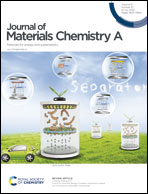A highly sensitive and selective nitric oxide/butanone temperature-dependent sensor based on waste biomass-derived mesoporous SnO2 hierarchical microtubes†
Abstract
Most currently reported metal oxide-based sensors are designed to monitor a given flammable or toxic gas. Hence, how to achieve a sensor with high response and selectivity towards different gases remains a challenge. To this end, a biomorphic SnO2 hierarchical structure was synthesized by a simple and controllable manner of SnCl4 impregnation and calcination in air using a waste tung seed shell as a biotemplate. The nanosheet-coated tube skeleton calcined at 600 °C is cross-linked by small-size nanoparticles (SnO2-6), and the inner surface of the tube wall is attached by “concave–convex” aggregates. Compared to the template-free SnO2 nanoparticles, the biomorphic SnO2-6 material also has a broad mesoporous distribution, a relatively large specific surface area and rich oxygen vacancy defects. These structural characteristics greatly promote gas molecule transmission and adsorption to the sensing layer, and effectively increase the amount of surface adsorbed oxygen species and active sites of the sensing material. Accordingly, the synergistic effect of these multiple factors significantly improves the sensing performance of SnO2-6 towards toxic and flammable gases. At a low working temperature of 92 °C, the SnO2-6 sensor presents a high response of 822.1 to 10 ppm NO and also possesses a high response of 50.1 to 100 ppm butanone vapor at 217 °C, which are superior to template-free SnO2 nanoparticles and the corresponding metal oxide sensors reported so far. In addition, it has a rapid response/recovery rate, good selectivity, satisfactory reproducibility and moisture resistance. Therefore, the SnO2-6 sensing material has potential applications in portable temperature-dependent dual-functional gas sensors.



 Please wait while we load your content...
Please wait while we load your content...